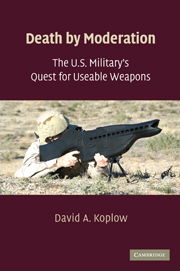Book contents
- Frontmatter
- Contents
- Preface
- Acknowledgments
- Abbreviations and Acronyms
- 1 Revolutionary Weapons and Transformed War
- 2 Deterrence and Self-Deterrence
- 3 The Law of Armed Conflict
- 4 Precision-Guided Munitions
- 5 Low-Yield Nuclear Weapons
- 6 Smart Antipersonnel Land Mines
- 7 Antisatellite Weapons
- 8 Nonlethal Weapons
- 9 What to Do about Useability
- Index
- References
6 - Smart Antipersonnel Land Mines
Published online by Cambridge University Press: 05 June 2012
- Frontmatter
- Contents
- Preface
- Acknowledgments
- Abbreviations and Acronyms
- 1 Revolutionary Weapons and Transformed War
- 2 Deterrence and Self-Deterrence
- 3 The Law of Armed Conflict
- 4 Precision-Guided Munitions
- 5 Low-Yield Nuclear Weapons
- 6 Smart Antipersonnel Land Mines
- 7 Antisatellite Weapons
- 8 Nonlethal Weapons
- 9 What to Do about Useability
- Index
- References
Summary
Scenario 6
The United States is preparing to assist remote Kafiristan in its defense against an imminent invasion. Kafiristan is small, underdeveloped, and vulnerable; it is likely to be seriously outgunned and outmanned on the battlefield, and the most effective component of its resistance to the aggression is likely to be sheer geography – its mountainous terrain affords the attacker few easy routes for invasion, and most natural conduits are pockmarked by chokepoints and possibilities for ambush.
A hastily drawn strategic plan incorporates as many diverse military elements as the United States, Kafiristan, and a handful of other supporting states are able to cobble together. Air superiority will be crucial, but there is not much time to build up the infrastructure necessary to sustain full-scale aerial operations. Still less feasible is any immediate massive insertion of heavy ground-based equipment – it is not easy to transport large quantities of tanks and artillery into this isolated theater of battle. Even the task of assembling an appreciable pool of military manpower and supplies will consume time and logistics energies. The initial concept of operations, therefore, necessarily emphasizes defensive stalling – a holding operation, to cede ground to the aggressor only slowly, hoping to buy time to permit major reinforcements to arrive.
Land mines figure into the plan in three ways. First, Kafiristan over the years had taken the precaution of erecting solid defensive barriers along its most tempestuous borders. These battlements include expansive fields of emplaced automatic explosives, both antitank mines and antipersonnel mines, designed to complicate the task of an attacker and to slow any advance.
- Type
- Chapter
- Information
- Death by ModerationThe U.S. Military's Quest for Useable Weapons, pp. 132 - 149Publisher: Cambridge University PressPrint publication year: 2009



